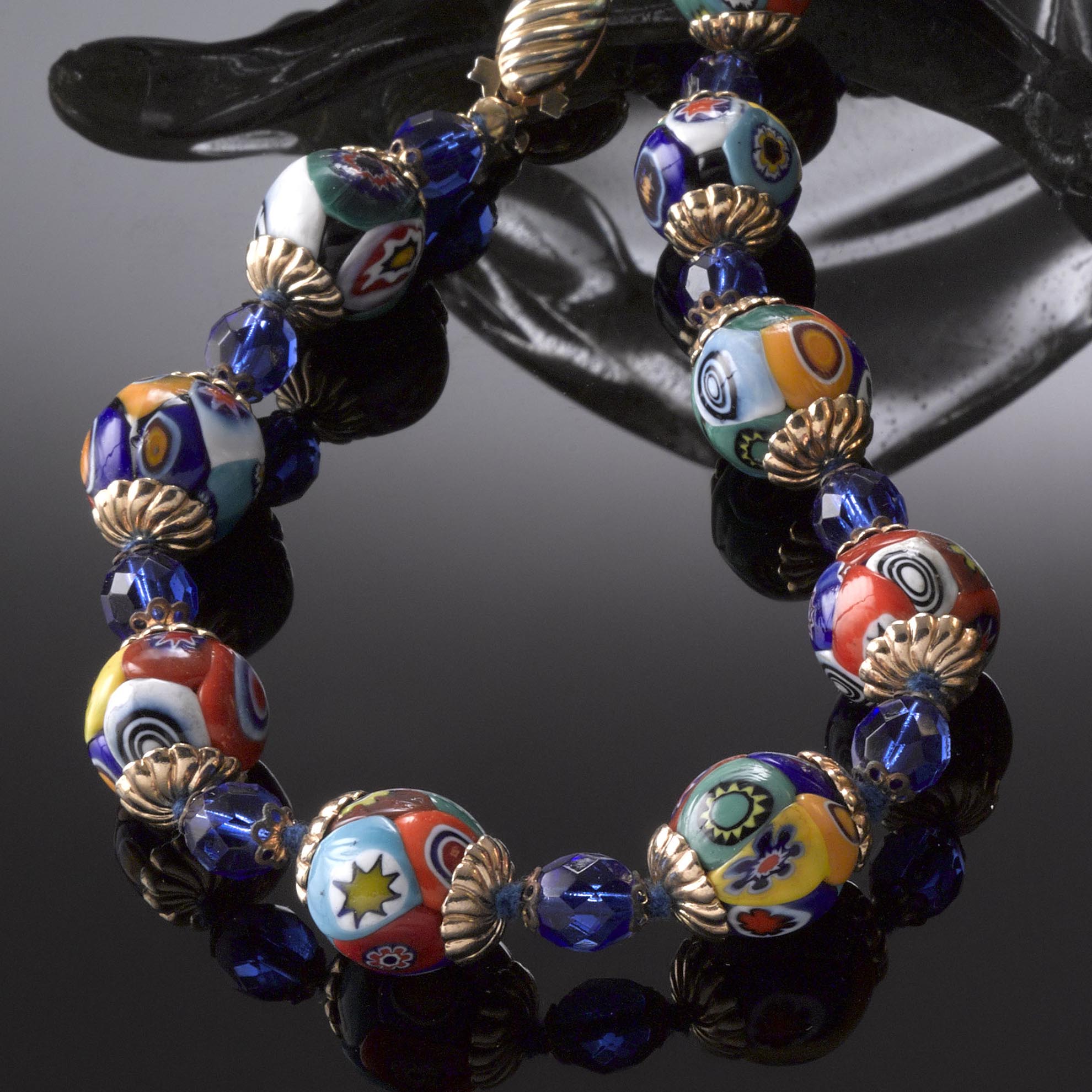Pearls

Pearls
A bit of history
With the discovery of the Neanderthal man (40,000 years ago) we find the first pearls, from animal bones and teeth.
10,000 years later they are used as amulets to be worn around the neck, in the form of a woman's breasts and animal heads.
The ice age interrupts the era of pearls.
Only around 6,000 BC reborn in Syria, Lebanon and Turkey, in the form of hard stones, amber and coral; they are used throughout the Mediterranean basin as a bargaining chip.
It is not known with certainty either where or when the discovery of glass occurred, but it is assumed around the first millennium BC
With the manifestation of the decline of the glass industry in the Middle East, the art of glass flourishes in Venice (the first documents of activity date back to the 10th century).
First testimony of Venetian pearls: beginning of the 1300s (in this period the pearls were used for rosaries: «paternostri»).
The "parternosteri" or "supialume" or "perleri" made pearls with the lamp; at the end of the 1400s the «margariteri» appear.
The margarita pearls were obtained starting from a perforated glass rod in its entire length and cut into many small cylinders, which were reduced to a sphere using the «ferazza»; the ferazza is the typical instrument of the margaritere, a kind of large iron tray on which the pieces of pierced cane were placed; the ferazza was then exposed to fire and kept in continuous movement, until the heat transformed the small cylinders into as many spheres.
Perleri also made pearls, but following a completely different technique. In fact they were also called supialume because their main working tool was a lamp whose flame was enhanced by a flow of air.
While the margaritiere at one time drew a large number of pearls all the same, whose characteristics were determined by the type of cane used, the perlèr built his pearls one by one, rolling the glass obtained by melting the fire around a metal needle of the light of the variously colored thin glass rods.
Perla rosetta: creation of Maria Barovier (1480), daughter of Angelo, inventor of crystal glass: glass rods perforated with concentric colored sections.
In the 1600s luxury in Venice spread, women's clothes were adorned with embroidery of colored pearls with gold and silver enamels: in this century the demand for paternoster and margarite grew stronger and the international market expanded considerably thanks also to new geographical discoveries.
It is a period of great activity, 251 pearl manufacturers work in Venice.
In the last years of the nineteenth century the export of Venetian pearls to the United States reaches 2,700 tons per year.
Also in these last years, with the production of pearls of great artistic quality, the Venetian industry maintains its place in the international sphere and Venetian pearls are increasingly appreciated for their beauty and elegance.
10,000 years later they are used as amulets to be worn around the neck, in the form of a woman's breasts and animal heads.
The ice age interrupts the era of pearls.
Only around 6,000 BC reborn in Syria, Lebanon and Turkey, in the form of hard stones, amber and coral; they are used throughout the Mediterranean basin as a bargaining chip.
It is not known with certainty either where or when the discovery of glass occurred, but it is assumed around the first millennium BC
With the manifestation of the decline of the glass industry in the Middle East, the art of glass flourishes in Venice (the first documents of activity date back to the 10th century).
First testimony of Venetian pearls: beginning of the 1300s (in this period the pearls were used for rosaries: «paternostri»).
The "parternosteri" or "supialume" or "perleri" made pearls with the lamp; at the end of the 1400s the «margariteri» appear.
The margarita pearls were obtained starting from a perforated glass rod in its entire length and cut into many small cylinders, which were reduced to a sphere using the «ferazza»; the ferazza is the typical instrument of the margaritere, a kind of large iron tray on which the pieces of pierced cane were placed; the ferazza was then exposed to fire and kept in continuous movement, until the heat transformed the small cylinders into as many spheres.
Perleri also made pearls, but following a completely different technique. In fact they were also called supialume because their main working tool was a lamp whose flame was enhanced by a flow of air.
While the margaritiere at one time drew a large number of pearls all the same, whose characteristics were determined by the type of cane used, the perlèr built his pearls one by one, rolling the glass obtained by melting the fire around a metal needle of the light of the variously colored thin glass rods.
Perla rosetta: creation of Maria Barovier (1480), daughter of Angelo, inventor of crystal glass: glass rods perforated with concentric colored sections.
In the 1600s luxury in Venice spread, women's clothes were adorned with embroidery of colored pearls with gold and silver enamels: in this century the demand for paternoster and margarite grew stronger and the international market expanded considerably thanks also to new geographical discoveries.
It is a period of great activity, 251 pearl manufacturers work in Venice.
In the last years of the nineteenth century the export of Venetian pearls to the United States reaches 2,700 tons per year.
Also in these last years, with the production of pearls of great artistic quality, the Venetian industry maintains its place in the international sphere and Venetian pearls are increasingly appreciated for their beauty and elegance.

Conterie
Small glass beads, round or oval, regular or irregular and of various colors, which were sold in large quantities, strung like necklaces, to make decorations. They were made from a very thin glass tube cut into short segments and then rounded off by heating them. The ancient Venetian name, now obsolete, was «margarite», from the Latin margarita = pearl
The term conteria meant originally the only candlelight pearls whose production was asserted in Venice starting from the sixteenth century. Only from the nineteenth century the term was extended to all glass pearl productions. The most probable etymology of the term is to be found in the Latin comptus, ornate, through the vulgar contigia.
The art of the Perleri, or Supialume, was recognized by the Senate in 1528. From 1604 even Margariteri and Paternostreri met in an autonomous corporation with their own altar in the church of S. Francesco della Vigna, in Castello, an area of maximum concentration of their laboratories.
With the new Capitolare of the Art of the Verieri, of 1776, the workings of the glass were divided into four classes: the Specchieri, Suoialume, Margaritieri and Verieri.
Despite the foreign competition, the glass industry was, among the Murano glass productions, the one that reached the best conditions at the end of the XVIII century, registering a particularly happy period in the ten years preceding the fall of the Republic. In 1780 there were, between Venice and Murano, twenty-six glassworks factories, which occupied 4264 workers and 900 laboratories of light kinds with 1800 workers.
Glass cane is produced in Murano in compliance with the law of 1291, which required the transfer of glass furnaces to the island, in order to avoid fires in the city.
The production of pearls from the perforated barrel is divided into nine phases.
The first operation is that of the cernidore that separated the canes the second of the thickness; the cutters cut them into small pieces which are then sifted by the squirters to eliminate the waste. To close the hole, so that it does not close on the second firing, the fregadori rub the glass segments with a mixture of lime, charcoal and water. The tubes round the beads to the furnace, the wardrobes remove the filling of the hole, the governors sift the scraps and finally the lustradors clean them. The pearls, ready to be threaded, are distributed, through the mediation of the teachers (mistre) to the threading machines, the impiraresse. Ipiraresse work mainly in the home or in small laboratories generally specialized in the making and packaging of objects with Murano pearls.
The term conteria meant originally the only candlelight pearls whose production was asserted in Venice starting from the sixteenth century. Only from the nineteenth century the term was extended to all glass pearl productions. The most probable etymology of the term is to be found in the Latin comptus, ornate, through the vulgar contigia.
The art of the Perleri, or Supialume, was recognized by the Senate in 1528. From 1604 even Margariteri and Paternostreri met in an autonomous corporation with their own altar in the church of S. Francesco della Vigna, in Castello, an area of maximum concentration of their laboratories.
With the new Capitolare of the Art of the Verieri, of 1776, the workings of the glass were divided into four classes: the Specchieri, Suoialume, Margaritieri and Verieri.
Despite the foreign competition, the glass industry was, among the Murano glass productions, the one that reached the best conditions at the end of the XVIII century, registering a particularly happy period in the ten years preceding the fall of the Republic. In 1780 there were, between Venice and Murano, twenty-six glassworks factories, which occupied 4264 workers and 900 laboratories of light kinds with 1800 workers.
Glass cane is produced in Murano in compliance with the law of 1291, which required the transfer of glass furnaces to the island, in order to avoid fires in the city.
The production of pearls from the perforated barrel is divided into nine phases.
The first operation is that of the cernidore that separated the canes the second of the thickness; the cutters cut them into small pieces which are then sifted by the squirters to eliminate the waste. To close the hole, so that it does not close on the second firing, the fregadori rub the glass segments with a mixture of lime, charcoal and water. The tubes round the beads to the furnace, the wardrobes remove the filling of the hole, the governors sift the scraps and finally the lustradors clean them. The pearls, ready to be threaded, are distributed, through the mediation of the teachers (mistre) to the threading machines, the impiraresse. Ipiraresse work mainly in the home or in small laboratories generally specialized in the making and packaging of objects with Murano pearls.












